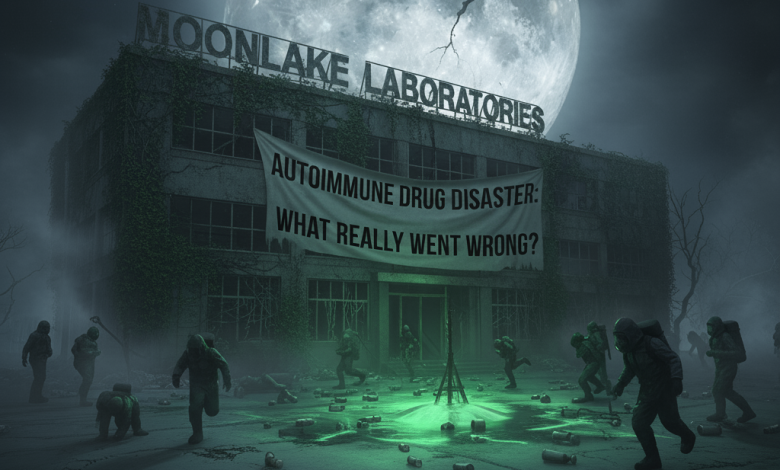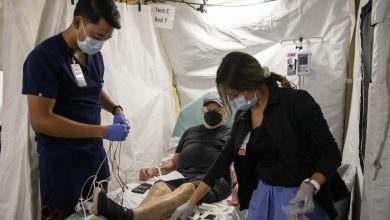MoonLake’s Autoimmune Drug Disaster: What Really Went Wrong?

MoonLake’s Autoimmune Drug Disaster has become a cautionary tale almost overnight. Once hailed as a breakthrough contender in treating hidradenitis suppurativa (HS) and other inflammatory conditions, MoonLake Immunotherapeutics saw its lead candidate, the Nanobody® sonelokimab, produce mixed Phase 3 results that wiped out billions in market value and left scientists, investors, and patients asking the same question: how did a high-profile drug program with strong early promise end up in such a sudden crisis?
The short version: two trials, one success, one failure
At the center of the debacle are two nearly identical Phase 3 trials in hidradenitis suppurativa (HS), a painful chronic inflammatory skin disease. MoonLake released week-16 results from the VELA program showing that sonelokimab met the primary endpoint in one of the two pivotal trials but failed to reach statistical significance in the other. Investors had expected consistent, clear wins; instead they got mixed results — and the market punished the company ruthlessly. Within a single trading session the company’s shares plunged by around 80–90%, erasing billions of dollars in market capitalization.
Why mixed results are catastrophic in biotech
Drug development — especially in immunology and dermatology where placebo responses can be volatile — is probabilistic. But investors buy Phase 3 consistency: two positive, confirmatory trials are typically required for broad regulatory approval and commercial confidence. When one trial succeeds and one fails, ambiguity overwhelms optimism. Companies face costly options: run another Phase 3, seek regulatory advice for a conditional path, or pursue a narrower label. Each option destroys value relative to the expected fast path to market that investors priced into MoonLake. The markets reacted as they often do: the promise of a blockbuster gave way to the realization of substantial regulatory and commercial uncertainty.
The placebo problem: unusually high placebo responses
A critical proximate cause of failure was a higher-than-expected placebo response in the failed study. Clinical trials in dermatology and pain-related conditions are increasingly challenged by placebo effects — improvements in the placebo arm driven by patient expectations, site variability, or measurement noise. MoonLake itself cited an unexpectedly high placebo response rate as the immediate explanation for the discrepancy between the two trials. When a placebo arm performs unusually well, it compresses the apparent treatment effect and can convert a true but modest drug benefit into a non-statistically significant outcome. That statistical fragility is lethal in late-stage programs.
Trial design and endpoint sensitivity
Beyond placebo noise, several design elements can amplify sensitivity to random variation:
- Primary endpoint choice: HS trials commonly use HiSCR (Hidradenitis Suppurativa Clinical Response) thresholds. Small differences in scoring or baseline patient characteristics can materially change results.
- Site heterogeneity: Multinational Phase 3 programs can include sites with different diagnostic rigor and patient populations; imbalance across these can skew outcomes.
- Patient selection and disease severity: If one trial enrolled a subtly different severity mix or comorbidity profile, efficacy signals could diverge.
- Timing of readout: Week-16 reads are early; some therapies demonstrate clearer separation from placebo at longer follow-ups.
Analysts now speculate that the combination of endpoint sensitivity, patient heterogeneity, and an unexpectedly strong placebo effect pushed one trial under the statistical cutoff even though the drug showed activity in the other trial.
Competition and commercial realities: why a marginal win isn’t enough
Even before the readouts, sonelokimab was not entering a vacuum. UCB’s Bimzelx (bimekizumab) — an IL-17 dual inhibitor — is already on the market and showed robust efficacy in HS, setting a high bar. When one of MoonLake’s trials showed only modest incremental benefit over placebo and overall efficacy that looked similar to existing options, the value proposition evaporated. Investors realized that even if MoonLake managed to secure approval, payer negotiations, market uptake, and physician preference might favor established drugs. In short: marginal clinical advantages in a crowded class are rarely enough to justify the prior valuations assigned to a small biotech.
Corporate communication and market timing missteps
How a company communicates trial nuances can either calm markets or inflame panic. MoonLake released topline figures and quickly said it would consult regulators about the path forward — a rational move — but in a market primed for “binary outcomes,” mixed language invited worst-case interpretations. Some critics argue that MoonLake (and some biotech firms generally) allowed investor expectations to build unchecked, positioning sonelokimab as a likely winner without adequately caveating the statistical risks inherent in the program. When the mixed readout hit, the communication window narrowed and volatility spiked.
The investor cascade: downgrades, lawsuits, and fire sales
The immediate financial consequences were predictable: analysts downgraded coverage, short interest and regulatory scrutiny rose, and class-action investor lawyers opened investigations into alleged misstatements or incomplete disclosures. Several firms issued investor alerts and predictions of further downside. This legal and financial cascade amplifies the operational problem: while management tries to decide whether to run an additional trial or seek a narrower regulatory path, it must do so with a severely reduced cash runway and a damaged market reputation.
Regulatory options: what MoonLake can (and can’t) do
When a company posts mixed Phase 3 results, the main realistic regulatory paths are:
- Discuss with regulators (FDA/EMA) to see if a single positive trial plus supporting data may suffice for conditional approval — rare and typically reserved for life-threatening illnesses or orphan populations. MoonLake indicated it would seek regulatory guidance.
- Conduct an additional Phase 3 to resolve uncertainty — expensive and time-consuming, but it can restore confidence if positive.
- Pivot indications or target a narrower label where the effect size may be larger (e.g., subgroups shown to benefit).
- Partner or sell the asset/company to a larger group with deeper pockets and appetite for risk.
Each option has costs. Regulators will ask for robust justification to rely on a single positive trial; running a new Phase 3 requires capital and time; and selling during a valuation trough forces concessions.
Lessons for clinical development teams
MoonLake’s Autoimmune Drug Disaster illustrates several practical lessons:
- Plan for placebo volatility: Proactively design trials with mitigation strategies — centralized training for sites, harmonized patient assessments, run-in periods, and statistical plans that account for variability.
- Be conservative in commercial projections: Overhyping incremental advantages against established therapies invites unforgiving market corrections.
- Transparent, timely communication: Deliver clear, contextualized trial updates that explain uncertainty and possible scenarios; avoid overly bullish framing.
- Contingency financing: Ensure sufficient capital to respond to adverse outcomes (additional trials, regulator meetings) without fire-selling assets.
- Biology matters: Translational work that clarifies which patient subgroups are most likely to respond can enable smarter trial enrichment and reduce the chance of noisy results.
These are not theoretical lessons — they are practical guardrails that could have changed the trajectory of sonelokimab’s program.
Patient perspective: hopes, disappointments, and ongoing needs
For patients with HS — a condition that causes pain, scarring, and a profound impact on quality of life — these headlines are not just market noise; they are a real emotional roller coaster. Clinical trial participants volunteered time and risked hope for better treatments. Mixed results mean delayed access and prolonged uncertainty. Patient advocacy groups will press companies and regulators to be transparent about timelines and future trial plans, and clinicians will refine treatment algorithms around available therapies. The human dimension of MoonLake’s Autoimmune Drug Disaster should not be forgotten in the financial coverage.
Could the program be salvaged?
Yes — but it won’t be easy. If the positive signal in the successful trial is robust and the safety profile remains clean, MoonLake might:
- Engage regulators about conditional approval or accelerated pathways (unlikely but possible in specific contexts).
- Design a new, targeted Phase 3 with enriched patient selection to reduce heterogeneity and placebo noise.
- Seek a strategic partner who can fund and operationalize additional development.
- Publish granular data to let independent scientists examine subgroup effects that could point to responder populations.
Several biotech stories have turned around after mixed readouts — but only when companies have the capital, strategic clarity, and biological rationale to execute a convincing next step.
Broader implications for biotech investing and drug development
MoonLake’s case underscores two enduring truths about biotech:
- Binary outcomes drive markets: Small data differences become existential when valuations depend on blockbuster potential.
- Robust translational science and statistical design matter as much as the molecule itself. Advances in biomarker-driven enrichment, adaptive trial designs, and reproducible endpoints are not academic luxuries; they are survival tools for modern drug development.
Investors and companies alike should recalibrate how early promise is communicated and how risk is managed — particularly as immunology programs face complex biology and noisy clinical readouts.
Final verdict: mixed science, high stakes, and a costly wake-up call
MoonLake’s Autoimmune Drug Disaster is not a single failure but the confluence of biological complexity, clinical trial fragility, commercial competition, and market psychology. Sonelokimab’s mixed Phase 3 results reveal how an otherwise promising mechanistic approach can be neutralized by placebo rates, endpoint sensitivity, and tough comparators. For MoonLake, the path forward will require honest scientific introspection, disciplined trial design, and pragmatic corporate strategy — and even then, success is far from guaranteed.
For the broader field, the episode is a sobering reminder: in modern drug development, scientific plausibility must be married to rigorous trial design and realistic commercialization planning. Otherwise, even bright ideas can become headline disasters.
Sources and further reading
Selected reporting and primary sources used to prepare this article include MoonLake’s investor releases, clinicaltrials.gov entries for sonelokimab’s HS studies, and contemporaneous coverage from STAT, BiopharmaDive, FierceBiotech, Barron’s, and Bloomberg — which reported on the trial results, the company’s statements, and the market reaction.




